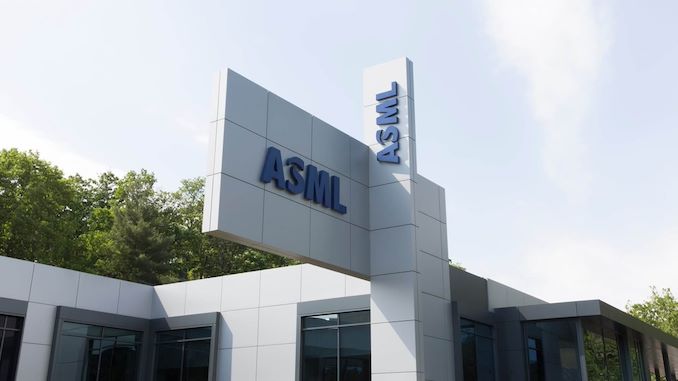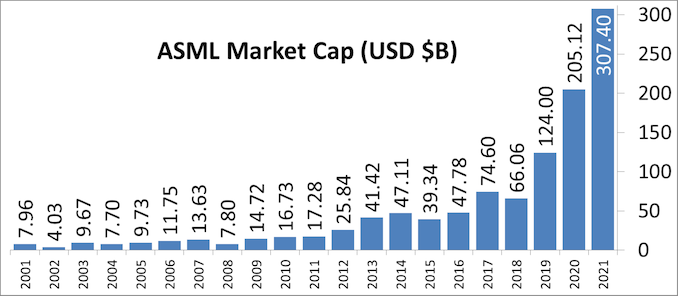Intel's Process Roadmap to 2025: with 4nm, 3nm, 20A and 18A?!
by Dr. Ian Cutress on July 26, 2021 5:00 PM ESTSidebar on Intel EUV
In all of these announcements, one thing to highlight is Intel mentioning its relationship with ASML, the sole company that manufactures the EUV machines powering production of leading edge semiconductor manufacturing.
ASML is a unique company in that it is the only one that can produce these machines, because the technology behind them is often tied up with its partners and research, but also because all the major silicon manufacturers are heavily invested in ASML. For any other company to compete against ASML would require building a separate network of expertise, a decade of innovation and design, and a lot of capital. None of the major silicon vendors want to disturb this balance and go off on their own, lest it shuts them out of the latest manufacturing technology, and no research fund sees competing against the embedded norm as a viable opportunity. This means that anyone wanting EUV specialist technology has to go to ASML.
In 2012, it was reported that Intel, Samsung, and TSMC all invested in ASML. This was, at the time, to jumpstart EUV development along with migrating from 300mm wafers to 450mm wafers. While we haven’t moved to 450mm wafers yet (and there are doubts we will any time in the next decade), EUV is now here. Intel’s 2012 investment of $2.1 billion gave them a 10% stake in ASML, with Intel stating that it would continue investing up to a 25% stack. Those stakes are now below the 5% reporting threshold, but all three of the major foundry customers are still big owners, especially as ASML’s market cap has risen from $24 Billion in 2012 to $268 Billion in 2021 (surpassing Intel).
As major investors but also ASML’s customers, the race has been on for these foundries to acquire enough EUV machines to meet demand. TSMC reported in August 2020 that it has 50% of all EUV machines manufactured at ASML for its leading edge processes. Intel is a little behind, especially as none of Intel’s products in the market yet use any EUV. EUV will only intercept Intel’s portfolio with its new Intel 4 process, where it will be used extensively, mostly on the BEOL. But Intel still has to order machines when they need them, especially as there are reports that ASML currently has backorders of 50 EUV machines. In 2021, ASML is expected to manufacture around 45-50 machines, and 50-60 in 2022. The exact number of machines Intel has right now, or has ordered from ASML, is unknown. It is expected that each one has a ~$150m price tag, and can take 4-6 months to install.
With all that being said, Intel’s discussion point today is that it will be the lead customer for ASML’s next generation EUV technology known as High-NA EUV. NA in this context relates to the ‘numerical aperture’ of the EUV machine, or to put simply, how wide you can make the EUV beam inside the machine before it hits the wafer. The wider the beam before you hit the wafer, the more intense it can be when it hits the wafer, which increases how accurately the lines are printed. Normally in lithography to get better printed lines, we move from single patterning to double patterning (or quad patterning) to get that effect, which decreases yield. The move to High-NA would mean that the ecosystem can stay on single patterning for longer, which some have quoted as allowing the industry to ‘stay aligned with Moore’s Law longer’.
| ASML's EUV Shipments | |||||||||||||||||||||
| 2015 | 2016 | 2017 | 2018 | 2019 | 2020 | 2021 | |||||||||||||||
| Actual | 2 | 4 | 10 | 3 | 4 | 5 | 6 | 4 | 7 | 7 | 8 | 4 | 7 | 14 | 8 | 7 | 9 | - | - | ||
| Target (Total) | - | - | - | 20 (18) | 30 (26) | 35 (33) | 45-50 | ||||||||||||||
| 2018 and beyond is split per quarter for actual shipped numbers Data taken from ASML's Financial Reports |
|||||||||||||||||||||
Current EUV systems are NA 0.33, while the new systems are NA 0.55. ASML’s latest update suggests that it expects customers to be using High-NA for production in 2025/2026, which means that Intel is likely going to be getting the first machine (ASML NXE:5000 we think) in mid-2024. Exactly how many High-NA machines ASML intends to produce in that time frame is unknown, as if they flood the market, having the first won’t be a big win. However if there is a slow High-NA ramp, it will be up to Intel to capitalize on its advantage.













326 Comments
View All Comments
mode_13h - Thursday, August 12, 2021 - link
Distinguishing between editorial content and reporting separates the domain of fair and ethical reporting from one of advocacy. I think most major news organizations don't even let the same people who do reporting participate in op/ed.To suggest that all editorials are instances of "casual and sloppy thinking" just shows you don't really know what you're talking about.
mode_13h - Thursday, July 29, 2021 - link
You're missing the point, and yet you attack *my* post for being stupid. Which is really just a half-step away from an "ad hom".The point isn't that journalists should faithfully parrot what Intel says. I'm all for critical analysis of their claims, among other things. I don't even know why you'd think I wasn't.
The point is that they shouldn't try to *directly influence* the behavior of those they're reporting on. That violates impartiality, and I think you can see some of its more subtle effects in this article.
I worry that you're focusing so much on attacking me that you're losing the plot. I don't mind if you disagree with me, but when our exchanges cease to be productive, then it's veering in the direction of trolling.
wut - Thursday, July 29, 2021 - link
It's okay to not be charitable in your interpretations, but I don't believe your interpretation to be correct. It isn't a matter of Ian trying to appeal to Intel in order for Intel "to look better for itself"... It's a matter of whether or not a new naming convention that's more in line with the rest of the industry would reduce confusion and- yes- makes for an environment where the truth comes out more easily. To advocate for the truth- Isn't that also a journalist's job?mode_13h - Sunday, August 1, 2021 - link
> To advocate for the truth- Isn't that also a journalist's job?Nothing about Intel's convention is more truthful. If he were advocating for them to publish real density figures, that would be different. That *is* advocating for more transparency, and I think that's appropriate.
Oxford Guy - Thursday, July 29, 2021 - link
'I worry that you're focusing so much on attacking me that you're losing the plot.'mode_13 in a nutshell. Always tossing in blithe 'crystal ball/ouija board/tarot card' ad homs, whilst simultaneously feigning occupancy of the high road.
Consider yourself fortunate that I'm still replying to your posts at all.
GeoffreyA - Friday, July 30, 2021 - link
I support what Ian is doing, but what mode_13h is trying to say is, that by putting his hand in it, Ian is no longer an objective/impartial observer. He has influenced what he was observing and is now a part of that setup. In practice, though, not a problem, and his predecessor used to do the same thing.GeoffreyA - Friday, July 30, 2021 - link
Also, when you do something for someone, or even advise them, you tend to become more kindly disposed towards them.mode_13h - Sunday, August 1, 2021 - link
Yes, that's my point.mode_13h - Sunday, August 1, 2021 - link
> In practice, though, not a problemHow can you know? We can't run the counter-factuals and see what his coverage would be like had he not involved himself.
mode_13h - Sunday, August 1, 2021 - link
> Consider yourself fortunate that I'm still replying to your posts at all.Certainly not. Your replies are consistently rather vapid, offer little value to the discussion, and your posts serve mostly to derail it onto unrelated tangents. I think we'd probably do better without your contributions, entirely.